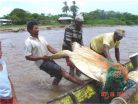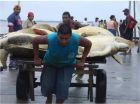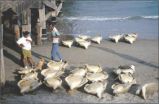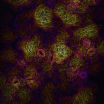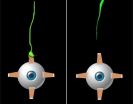(Press-News.org) A 20-year assessment of Nicaragua's legal, artisanal green sea turtle fishery has uncovered a stark reality: greatly reduced overall catch rates of turtles in what may have become an unsustainable take, according to conservation scientists from the Wildlife Conservation Society and University of Florida.
During the research period, conservation scientists estimated that more than 170,000 green turtles were killed between 1991 and 2011, with catch rates peaking in 1997 and 2002 and declining steeply after 2008, likely resulting from over-fishing. The trend in catch rates, the authors of the assessment results maintain, indicates the need for take limits on this legal fishery.
The study now appears in the online journal PLOS ONE. The authors are: Cynthia J. Lagueux and Cathi L. Campbell of the University of Florida (formerly of the Wildlife Conservation Society), and Samantha Strindberg of the Wildlife Conservation Society.
"The significant decrease in the catch rates of green turtles represents a concern for both conservationists and local, coastal communities who depend on this resource," said Dr. Lagueux, lead author of the study. "We hope this study serves as a foundation for implementing scientifically based limits on future green turtle take."
Caribbean coastal waters of Nicaragua contain extensive areas of sea grass, principal food source for green turtles, the only herbivorous sea turtle species. Green turtles in turn support a number of indigenous Miskitu and Afro-descendent communities that rely on the marine reptiles for income (by selling the meat) and as a source of protein.
The catch data used by the researchers to estimate trends was gathered by community members at 14 different sites located in two geographically political regions of the Nicaraguan coast. The research team analyzed the long-term data set to examine catch rates for the entire fishery, each region, and for individual turtle fishing communities using temporal trend models.
Over the duration of the assessment, the scientists recorded that at least 155,762 green turtles were caught; the overall estimated catch (factoring in estimated take during periods when data were not recorded) was 171,556 turtles. The average catch rate per fishing trip (assuming average fishing effort in terms of nets used and trip length) revealed an overall decline from 6.5 turtles to 2.8 turtles caught, representing a 56 percent decline over two decades.
In individual communities, catch rate declines ranged between 21 percent and 90 percent in green turtles caught over the 20-year period.
"These declining catch rates align with our survival rate estimates of green turtles exposed to the Nicaragua turtle fishery and population modelling, which suggested the fishery was not sustainable at high take levels reported in the 1990s," said Dr. Cathi Campbell.
The steep declines in green turtle catch rates, the researchers maintain, indicate a potential decline of green turtle populations that use Nicaragua's foraging grounds, particularly smaller rookeries in the Caribbean. The scientists note that the study results highlight the need for not only close monitoring of rookeries in the region, but also in-water aggregations of green turtles. Further, future research efforts should include the use of molecular technology to better refine Caribbean green turtle genetic stocks, specifically to identify populations most at risk from turtle fisheries.
"Given the importance of green turtles to Nicaragua's past, present and future, we encourage the communities, governmental agencies, and conservation groups to take measures that conserve and sustain these globally threatened populations, and to work together to ensure that the communities have alternative sources of protein and income into the future," said Dr. Caleb McClennen, Director of WCS's Marine Program.
Growing up to 400 pounds in weight, the green turtle is the second largest sea turtle species next to the leatherback turtle. The reptile inhabits the tropical and subtropical waters of the world. The species is listed as Endangered on the IUCN's Red List and on CITES (Convention on International Trade in Endangered Species of Wild Flora and Fauna) as an Appendix I species, a designation which prohibits all international commercial trade by member countries. In addition to the threat from overfishing (intentional take), the green turtle is at risk from bycatch in various fisheries (unintended take), poaching of eggs at nesting beaches, habitat deterioration and loss due to coastal development and climate change effects, and pollution.
INFORMATION:
Declining catch rates in Caribbean green turtle fishery may be result of overfishing
20-year study finds large decrease in green turtle catch rates
2014-04-17
ELSE PRESS RELEASES FROM THIS DATE:
In old age, lack of emotion and interest may signal your brain is shrinking
2014-04-16
MINNEAPOLIS – Older people who have apathy but not depression may have smaller brain volumes than those without apathy, according to a new study published in the April 16, 2014, online issue of Neurology®, the medical journal of the American Academy of Neurology. Apathy is a lack of interest or emotion.
"Just as signs of memory loss may signal brain changes related to brain disease, apathy may indicate underlying changes," said Lenore J. Launer, PhD, with the National Institute on Aging at the National Institutes of Health (NIH) in Bethesda, MD, and a member of the American ...
Dermatologists with access to sample drugs write costlier prescriptions, Stanford study finds
2014-04-16
STANFORD, Calif. — Dermatologists with access to free drug samples are more likely than those without access to samples to write prescriptions for drugs that are more expensive, according to a study by researchers at the Stanford University School of Medicine.
Although studies have shown that most physicians do not believe that the availability of free samples affects their behavior or recommendations for patients, the researchers found that the average retail cost of the prescriptions written by dermatologists with access to samples are about twice the cost of prescriptions ...
Free drug samples can change prescribing habits of dermatologists
2014-04-16
The availability of free medication samples in dermatology offices appears to change prescribing practices for acne, a common condition for which free samples are often available.
Free drug samples provided by pharmaceutical companies are widely available in dermatology practices.
The authors investigated prescribing practices for acne vulgaris and rosacea. Data for the study were obtained from a nationally representative sample of dermatologists in the National Disease and Therapeutic Index (NDTI), a survey of office-based U.S. physicians, and from an academic medical ...
Atypical brain connectivity associated with autism spectrum disorder
2014-04-16
Autism spectrum disorder (ASD) in adolescents appears to be associated with atypical connectivity in the brain involving the systems that help people infer what others are thinking and understand the meaning of others' actions and emotions.
The ability to navigate and thrive in complex social systems is commonly impaired in ASD, a neurodevelopmental disorder affecting as many as 1 in 88 children.
The authors used functional magnetic resonance imaging to investigate connectivity in two brain networks involved in social processing: theory of mind (ToM, otherwise known ...
For cells, internal stress leads to unique shapes
2014-04-16
From far away, the top of a leaf looks like one seamless surface; however, up close, that smooth exterior is actually made up of a patchwork of cells in a variety of shapes and sizes. Interested in how these cells individually take on their own unique forms, Caltech biologist Elliot Meyerowitz, postdoctoral scholar Arun Sampathkumar, and colleagues sought to pinpoint the shape-controlling factors in pavement cells, which are puzzle-piece-shaped epithelial cells found on the leaves of flowering plants. They found that these unusual shapes were the cell's response to mechanical ...
Researchers track down cause of eye mobility disorder
2014-04-16
Imagine you cannot move your eyes up, and you cannot lift your upper eyelid. You walk through life with your head tilted upward so that your eyes look straight when they are rolled down in the eye socket. Obviously, such a condition should be corrected to allow people a normal position of their head. In order to correct this condition, one would need to understand why this happens.
In a paper published in the April 16 print issue of the journal Neuron, University of Iowa researchers Bernd Fritzsch and Jeremy Duncan and their colleagues at Harvard Medical School, along ...
Scientists observe quantum superconductor-metal transition and superconducting glass
2014-04-16
The article "Collapse of superconductivity in a hybrid tin–grapheme Josephson junction array'" (authors: Zheng Han, Adrien Allain, Hadi Arjmandi-Tash,Konstantin Tikhonov, Mikhail Feigelman, Benjamin Sacépé,Vincent Bouchiat, published in Nature Physics on March 30, 2014, DOI:10.1038/NPHYS2929) presents the results of the first experimental study of the graphene-based quantum phase transition of the "superconductor-to-metal" type, i.e. transformation of the system's ground state from superconducting to metallic, upon changing the electron concentration in graphene sheet.
The ...
Stanford scientists develop 'playbook' for reverse engineering tissue
2014-04-16
STANFORD, Calif. — Consider the marvel of the embryo. It begins as a glob of identical cells that change shape and function as they multiply to become the cells of our lungs, muscles, nerves and all the other specialized tissues of the body.
Now, in a feat of reverse tissue engineering, Stanford University researchers have begun to unravel the complex genetic coding that allows embryonic cells to proliferate and transform into all of the specialized cells that perform myriad biological tasks.
A team of interdisciplinary researchers took lung cells from the embryos of ...
Red moon at night; stargazer's delight
2014-04-16
Monday night's lunar eclipse proved just as delightful as expected to those able to view it. On the East Coast, cloudy skies may have gotten in the way, but at the National Science Foundation's National Optical Astronomy Observatory (NOAO) near Tucson, Ariz., the skies offered impressive viewing, as seen from the pictures provided here.
Nicknamed a "blood moon," this lunar eclipse's color was similar to the majority of lunar eclipses. This has to do with the Earth's atmosphere's propensity for longer-wavelength light (e.g., the reds, oranges and yellows seen in sunrises ...
Information storage for the next generation of plastic computers
2014-04-16
Inexpensive computers, cell phones and other systems that substitute flexible plastic for silicon chips may be one step closer to reality, thanks to research published on April 16 in the journal Nature Communications.
The paper describes a new proposal by University of Iowa researchers and their colleagues at New York University for overcoming a major obstacle to the development of such plastic devices—the large amount of energy required to read stored information.
Although it is relatively cheap and easy to encode information in light for fiber optic transmission, ...
LAST 30 PRESS RELEASES:
Deadly bacteria show thirst for human blood
New insights could unlock immunotherapy for rare, deadly eye cancer
Biodiversity is key to the mental health benefits of nature, new study finds
A single atom layer of gold – LiU researchers create goldene
Most countries struggle to meet climate pledges from 2009
Photonic computation with sound waves
New study focuses on the placenta for clues to the development of gestational diabetes
Care home staff and residents need ‘family’ bonds to thrive
New Inflammatory Bowel Disease testing protocol could speed up diagnosis
Most massive stellar black hole in our galaxy found
New review offers first recommendations on accurately assessing the carbon footprint of coffee farming
Seed ferns: Plants experimented with complex leaf vein networks 201 million years ago
New statewide research reveals the staggering economic cost of intimate partner violence in Louisiana
From ashes to adversity: Lessons from South Australia's business recovery amidst bushfires and pandemic
Multiple pollutants from crop and livestock production in the Yangtze River: status and challenges
Unraveling the unique role of DELLA proteins in grapevine flowering: A shift in developmental fate
Next-generation treatments hitch a ride into cancer cells
Unraveling the role of DlBGAL9 and AGL61/80 in Longan somatic embryogenesis and heat stress tolerance: A multi-omics approach
Decoding pecan pollination: A dive into the chloroplast genome of 'Xinxuan-4' and its impact on cultivar diversity and efficiency
KD-crowd: A knowledge distillation framework for learning from crowds
Can animals count?
Australian media need generative AI policies to help navigate misinformation and disinformation
Illuminating the path to hearing recovery
Unlocking the secrets of fruit quality: How anthocyanins and acidity shape consumer preferences and market value
Evidence for reversible oxygen ion movement during electrical pulsing: enabler of the emerging ferroelectricity in binary oxides
Revolutionizing Citrus cultivation: The superior tolerance and growth vigor of 'Shuzhen No.1' rootstock
Family and media pressure to lose weight in adolescence linked to how people value themselves almost two decades later
Despite the desire to reduce the risk of imitation, new research suggests startups should scale slowly and steadily
The Lancet: Many people with breast cancer ‘systematically left behind’ due to inaction on inequities and hidden suffering
From opioid overdose to treatment initiation: outcomes associated with peer support in emergency departments
[Press-News.org] Declining catch rates in Caribbean green turtle fishery may be result of overfishing20-year study finds large decrease in green turtle catch rates
